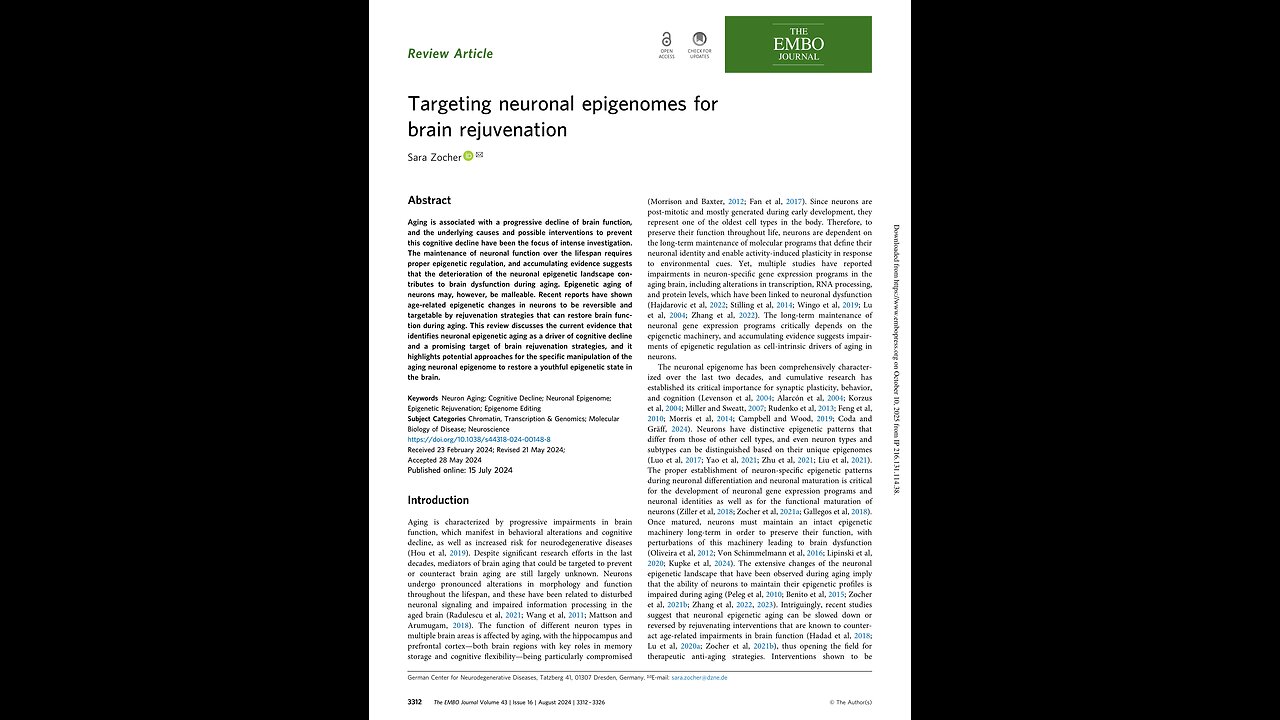Premium Only Content

Brain Rejuvenation, by Sara Zocher 2024. A Puke(TM) AudioPaper
Index of Other Science Articles:
https://rumble.com/v3t4yzj-index-of-science.-music-by-dan-vasc.html
Targeting neuronal epigenomes for brain rejuvenation.
Sara Zocher.
The EMBO Journal, 20 24.
Keywords:
Neuron Aging, Cognitive Decline, Neuronal Epigenome, Epigenetic Rejuvenation, Epigenome Editing, Chromatin, Transcription and Genomics, Molecular Biology of Disease, Neuroscience.
https://doi.org/10.1038/s44318-024-00148-8
Abstract.
Aging is associated with a progressive decline of brain function, and the underlying causes and possible interventions to prevent this cognitive decline have been the focus of intense investigation.
The maintenance of neuronal function over the lifespan requires proper epigenetic regulation, and accumulating evidence suggests that the deterioration of the neuronal epigenetic landscape contributes to brain dysfunction during aging. However, Epigenetic aging of neurons may be malleable. Recent reports have shown age-related epigenetic changes in neurons to be reversible and targetable by rejuvenation strategies that can restore brain function during aging. This review discusses the current evidence that identifies neuronal epigenetic aging as a driver of cognitive decline and a promising target of brain rejuvenation strategies, and it highlights potential approaches for the specific manipulation of the aging neuronal epigenome to restore a youthful epigenetic state in the brain.
Introduction.
Aging is characterized by progressive impairments in brain function, which manifest in behavioral alterations and cognitive decline, as well as increased risk for neurodegenerative diseases. Despite significant research efforts in the last decades, mediators of brain aging that could be targeted to prevent or counteract brain aging are still largely unknown. Neurons undergo pronounced alterations in morphology and function throughout the lifespan, and these have been related to disturbed neuronal signaling and impaired information processing in the aged brain. The function of different neuron types in multiple brain areas is affected by aging, with the hippocampus and prefrontal cortex, both brain regions with key roles in memory storage and cognitive flexibility, being particularly compromised since neurons are post-mitotic and mostly generated during early development, they represent one of the oldest cell types in the body. Therefore, to preserve their function throughout life, neurons are dependent on the long-term maintenance of molecular programs that define their neuronal identity and enable activity-induced plasticity in response to environmental cues. Yet, multiple studies have reported impairments in neuron-specific gene expression programs in the aging brain, including alterations in transcription, RNA processing, and protein levels, which have been linked to neuronal dysfunction.
The long-term maintenance of neuronal gene expression programs critically depends on the epigenetic machinery, and accumulating evidence suggests impairments of epigenetic regulation as cell-intrinsic drivers of aging in neurons.
The neuronal epigenome has been comprehensively characterized over the last two decades, and cumulative research has established its critical importance for synaptic plasticity, behavior, and cognition.
Neurons have distinctive epigenetic patterns that differ from those of other cell types, and even neuron types and subtypes can be distinguished based on their unique epigenomes.
The proper establishment of neuron-specific epigenetic patterns during neuronal differentiation and neuronal maturation is critical for the development of neuronal gene expression programs and neuronal identities as well as for the functional maturation of neurons.
Once matured, neurons must maintain an intact epigenetic machinery long-term in order to preserve their function, with perturbations of this machinery leading to brain dysfunction.
The extensive changes of the neuronal epigenetic landscape that have been observed during aging imply that the ability of neurons to maintain their epigenetic profiles is impaired during aging.
Intriguingly, recent studies suggest that neuronal epigenetic aging can be slowed down or reversed by rejuvenating interventions that are known to counteract age-related impairments in brain function, thus opening the field for therapeutic anti-aging strategies.
Interventions shown to be effective include changes to lifestyle, such as exercise, environmental enrichment, and caloric restriction, the transfer of young blood factors or cellular reprogramming, among others. The malleability of the neuronal epigenome during aging suggests that it can be targeted to prevent epigenetic aging or even restore a youthful epigenetic state in aged neurons.
This review investigates the role of neuronal epigenomes as molecular mediators of brain aging and potential targets to prevent cognitive decline. It first discusses the current evidence for neuronal epigenetic aging as a driver of cognitive decline, examining in detail different epigenetic modifications and highlighting current knowledge gaps and future research avenues. There follows a summary of recent studies that suggest neuronal epigenomes as critical targets and potential mediators of brain rejuvenation strategies. Finally, this article discusses approaches to specifically manipulate the aging neuronal epigenome with the goal to restore neuronal function in the aged brain.
Epigenetic changes underlying neuron aging.
Epigenetic regulation takes place on multiple interconnected layers in the nucleus; from DNA methylation to histone modifications that influence chromatin compaction to the three-dimensional distribution of chromatin in the nucleus and post-transcriptional modifications
The coordinated interaction between these epigenetic layers is critical for the establishment and maintenance of neuron-specific gene expression patterns
For most of these epigenetic marks, substantial alterations have been described in the brain during the course of aging, which correlated with dysregulated gene expression in a locus-specific manner, see figure one.
Indications for a functional role of epigenetic alterations in brain aging comes from manipulations of epigenomic regulator proteins, which profoundly affected neuronal gene regulation, behavior and cognitive abilities in young and aged mice.
Breakdown of neuronal DNA methylation landscapes.
Neurons have unique DNA methylation landscapes which are highly specific for neuron type and brain region. Single-cell DNA methylation sequencing has shown that even subtypes of interneurons and excitatory neurons as well as their spatial locationswithin the brain can be identified based on DNA methylation patterns, suggesting that DNA methylation contributes to the functional diversity of neurons. Neuronal DNA methylation landscapes are built up by
DNA methyl-transferases and recognized by methylation-sensitive transcription factors as well as DNA methylation reader proteins, such as Mecp2, that contain specific binding domains for methylated cytosines, to instruct neuronal gene expression. Perturbations of DNA methylation enzymes and reader proteins have demonstrated that neurons are dependent on an active DNA methylation machinery for gene regulation, synaptic plasticity, learning, and memory and recent studies suggest that the functional maintenance of this machinery is impaired during aging.
DNA methylation patterns have been profiled during aging in a genome-wide manner in both rodent and human brains. Those studies found pronounced age-related alterations in DNA methylation in the hippocampus and prefrontal cortex, with locus-specific DNA hyper or hypo methylation and a tendency toward reductions in global DNA methylation during aging.
DNA hypo-methylation in the aged hippocampus has been shown to be particularly pronounced at enhancers and gene bodies of neuronal plasticity and synapse-related genes, suggesting that the neuron-specific DNA methylation landscape is impaired in the aged brain.
Yet, these findings were derived from sequencing of dissected brain tissues and should be confirmed in purified neuron populations in future experiments. The sources of those age-related alterations in DNA methylation still remain unknown and conflicting results have been reported regarding alterations in the levels of the enzymes of the DNA methylation machinery. While some studies have reported reduced expression of DNA methyl-transferases or Tet DNA demethylases in the aged brain, other studies reported no age-related alterations in the levels of those enzymes in the brain.
A neuron type and brain region-specific analysis of age-related changes in expression and genomic binding of DNA methylation enzymes is still missing but would give valuable insight into the sources of age-related DNA methylation changes in the brain.
Although age-related alterations of DNA methylation patterns have been extensively characterized, their functional consequences on neuronal gene expression programs and neuronal plasticity are still incompletely understood. Evidence for a role of DNA methylation as a driver of neuronal dysfunction in aging comes from its locus-dependent correlation with perturbed gene expression and from studies manipulating regulatory enzymes of DNA methylation in young and aged brains.
For instance, the DNA methyl-transferase Dnmt3a is critical for hippocampal function in young animals and its overexpression in the aged hippocampus increased 5-methylcytosine levels and counteracted age-related cognitive decline. Moreover, overexpression of DNA demethylase Tet2 in the hippocampus of aged mice increased 5-hydroxymethylcytosine levels and promoted learning and memory.
In contrast, Tet2 overexpression in young mice impaired brain function, presumably due to accelerated demethylation in young neurons. In addition, recent studies suggested that the activity of DNA demethylases Tet1 and Tet2 is required for reprogramming-induced rejuvenation of neuronal function in the aged retina. For details, see “Neuronal reprogramming”, providing evidence that this functional improvement in aging is dependent on DNA methylation.
Besides these broad perturbations of DNA methylation enzymes, there is little molecular insight into the consequences of DNA methylation in aging. Particularly, how age-related alterations in DNA methylation affect neuronal gene regulation and neuronal plasticity is still incompletely understood. Our recent study suggested that hypo-methylation of neuronal plasticity-related genes at genomic binding sites of Mecp2 correlated with impaired Mecp2 binding and aberrant transcriptional activation of those loci.
Figure 1. The aging neuronal epigenome.
Neuron-specific epigenetic patterns are profoundly altered in the aged brain, contributing to impaired gene regulation and ultimately neuron dysfunction. The age-related degradation of the nuclear lamina affects the distribution of chromatin in the nucleus and leads to heterochromatin instability. At constitutively silenced, heterochromatin regions, loss of repressive H-3-K-9-me-3 and DNA hypo-methylation have been associated with spurious transcriptional activation of retrotransposons and neuro-inflammation.
Altered patterns of DNA methylation, histone marks and RNA methylation at regulatory elements and gene bodies of neuronal plasticity-related genes have been associated with impaired neuronal gene expression in the aged brain. Please note that the boxes “intact impaired neuronal gene regulation” depict schematic summaries of age-related epigenetic changes reported for different neuronal genes in separate studies. The simultaneous profiling of the depicted epigenetic marks in the same neuron type has not yet been reported, and the depicted epigenetic patterns will likely differ depending on the specific genomic locus.
Thus providing a potential mechanism underlying neuron aging. Locus-specific manipulations of DNA methylation in young and aged neurons would help in future studies to decipher the functional consequences of DNA methylation in brain aging at the molecular, cellular and behavioral level.
Altered histone marks and augmented chromatin accessibility.
Post-translational modifications of histones, of which acetylation and methylation of histone lysine residues are the most characterized, critically contribute to neuronal epigenetic regulation by controlling the accessibility of chromatin to regulatory proteins such as transcription factors and RNA polymerases. Single-cell profiling in the mouse brain showed that many histone modifications, such as H-3-K-27-ac or H-3-K27-me-3 which label active or silenced regulatory regions respectively, are distributed in a neuron type-specific manner and correlate with specific gene expression programs. A few studies profiled alterations in histone modifications during neuron aging and related those to functional deficits in the aged brain. In general, these studies found decreases in both repressing histone marks at heterochromatin regions and activating histone marks at neuronal plasticity-related genes, with many of these effects being dependent on genomic locus, neuron type, and neuronal activation status.
Histone methylation, such as H-3-K-9 or 27 me-3, generally marks chromatin regions that are inaccessible and repressed in a context-dependent or constitutive manner
Recent studies reported an age-related loss of repressive H-3-K-9-me-3 in neurons, which correlated with increased chromatin accessibility and aberrant transcriptional activation of the affected loci.
For instance, Zhang and colleagues found that excitatory neurons in the hippocampus and prefrontal cortex lose K9 and gain chromatin accessibility at constitutively silenced, heterochromatin regions, such as LINE-1 repetitive elements, which was linked to the spurious transcriptional activation of those regions in aged neurons. Chromatin accessibility was also increased at regions that contain binding sites of activity-induced transcription factors, such as Jun, AP-1, Atf3, suggesting that the binding of those transcription factors might be altered in aged neurons. Although the functional interaction between histone methylation, chromatin accessibility and gene expression during aging has not yet been addressed comprehensively, both increased accessibility and global reduction of constitutive heterochromatin likely result in neuronal gene dysregulation, particularly of genes that are normally silenced in unstimulated neurons. In addition, accumulation of repressive K9 and K27 at the promoters of neuronal plasticity genes during aging has been reported, which correlated with reduced transcript levels, suggesting that increased repressive histone methylation at specific neuronal genes might hamper neuronal plasticity during aging. In line with this, acute pharmacological inhibition of histone lysine methyl-transferase Suv-39-h1 before a learning and memory test promoted neuronal plasticity and cognitive abilities in aged mice.
It is interesting that many of the age-related histone and chromatin accessibility changes have been found to be cell type-specific, with increased accessibility and reduced K9 in aged excitatory neurons but not in inhibitory neurons or glia.
Unraveling the consequences of neuron type-specific aging signatures would improve our understanding of neuronal epigenetic aging in the future.
Histone acetylation controls activity-dependent gene induction in neurons, and the enzymes that catalyze acetylation, histone acetyltransferases, play important roles in learning and memory.
Histone deacetylases HDAC’s, in contrast, typically negatively regulate cognitive processes, and the disturbed activity of these enzymes has been implicated in brain aging.
Benito and colleagues found that, during aging, activating H-4K-12-ac is reduced in excitatory neurons but not in non-neuronal cells of the dorsal hippocampus
This reduction was particularly pronounced at gene bodies of synaptic genes where it correlated with altered RNA splicing, specifically the aberrant inclusion of exons in aged neurons. In an earlier study, the same group reported that learning-induced accumulation of K12 at activity-induced genes was impaired in the aged hippocampus, leading to disturbed induction of activity-induced gene expression programs in the aged brain. Other studies found an age-related reduction of activating K27 in the mouse and human brain.
For example, reduced K-27-ac and increased K-27-me-3 at the Bdnf promoter correlated with reduced transcript levels.
Rescue of age-associated changes in neuronal K12, K27 and gene expression could be achieved by systemic treatment with HDAC inhibitor suberoylanilide hydroxamic acid, which also promoted cognitive abilities in aged mice.
While these results suggest that accelerated deacetylation by HDAC’s underlies reduced histone acetylation in aged neurons, other studies reported that reduced K27 in aged neurons also correlated with decreased binding of the histone acetyltransferase CBP.
Likely, both the reduced maintenance of acetylation and accelerated deacetylation contribute to age-related alterations of the histone acetylation landscape.
Disrupted nuclear architecture.
In addition to chromatin accessibility at specific gene loci, neuronal epigenetic landscapes are shaped by nuclear architecture, meaning, the three-dimensional (3D) chromatin structure in the nucleus. Major advances in epigenomic sequencing technologies in the last years have made it possible to assess 3D chromatin structures of neurons in a genome-wide manner and even at single nucleus resolution.
These studies found that neurons show characteristic 3D chromatin structures that differ between neuron types at specific neuronal genes, are activity-dependent and correlate with other epigenetic marks and gene expression.
A few recent studies have suggested that the maintenance of the neuronal 3D chromatin architecture is impaired during aging.
The distribution of chromatin in the nucleus is predominantly controlled by nuclear structural proteins, including nuclear lamins which anchor heterochromatin at the nuclear periphery. Age related decreases in lamin protein levels have been reported in excitatory and inhibitory neurons in mouse, primate and human brains, resulting in impaired nuclear integrity in aged neurons. For instance, Zhang and colleagues suggested that age-related reductions in lamin B1 and B2 levels in primate cortical neurons result in loss of heterochromatin and aberrant activation of repetitive elements, including endogenous retroviruses, ultimately inducing inflammatory pathways in aging neurons. However, the consequences of age related lamin reductions on genome-wide 3D chromatin distribtions were not examined. Tan and colleagues profiled 3D chromatin distributions across the lifespan in the mouse and human cerebellum and found alterations in chromatin A B compartments in cerebellar granule cells during aging. Specifically, they reported an increase in the fraction of ultra-long-range intra-chromosomal contacts and a re-distribution of specific inter-chromosomal contacts in the aged mouse and human cerebellum. These data show that aging profoundly alters the nuclear architecture in neurons, yet the consequences of those alterations for neuronal epigenetic regulation and neuronal function remain to be investigated.
Altered RNA metabolism.
Neuronal function also depends on post-transcriptional mechanisms that control RNA stability, RNA degradation, RNA transport and translation, and particularly RNA modifications such as RNA methylation have been implicated as mediators of these processes.
Recent studies have reported that RNA methylation patterns are disrupted in the aged brain, potentially contributing to cognitive decline.
For instance, Castro-Hernandez and colleagues profiled m-6-A RNA methylation in the hippocampus and cortex of 3-month-old and 16-month-old mice and found pronounced age-related hypo-methylation at the gene bodies of synaptic plasticity related RNA’s, which they related to impairments in local translation at synapses.
Many of those RNA’s were also hypo-methylated in the cortex of Alzheimer’s disease patients, suggesting that aging or neurodegeneration-related effects on RNA methylation are conserved in humans. Shafik and colleagues also found age-related changes in RNA methylation in the mouse hippocampus and cortex, yet they reported a predominant Hyper-methylation of gene bodies in 1-year-old mice compared to 6-week-old adolescent mice. A comprehensive characterization of purified neuron populations from multiple mouse ages might help to clarify in future experiments the dynamics of neuronal RNA methylation changes over the lifespan.
In addition to the classical epigenetic modifications described above, RNA molecules themselves can participate in transcriptional and post-transcriptional regulation, which is subject to age-related impairments. For instance, noncoding RNA’s have emerged as important regulators of neuronal development and synaptic plasticity, and alterations in their levels have been linked to cognitive impairments.
Transcriptomic profiling has shown that many noncoding RNA’s, including lnc-RNA’s and mi-RNA’s, are dysregulated in the aged brain, with several of those having established functions as regulators of synaptic plasticity and cognition.
The dysregulation of noncoding RNA’s is likely connected to age-related alterations of classical epigenetic marks, such as DNA and histone modifications, although this interplay has not yet been comprehensively assessed during neuron aging. In other systems, it is known that the levels of noncoding RNA’s are controlled by epigenetic marks, and noncoding RNA’s, in turn, can alter epigenetic modifications by guiding chromatin remodeling proteins to regulatory genomic regions or through directly regulating the expression of epigenetic enzymes.
It would be interesting to dissect, in future experiments, the functional interaction between noncoding RNA’s and DNA RNA histone modifications during neuron aging.
Some non-canonical functions of RNA have also been linked to epigenetic regulation and might have roles in neuron aging. For instance, a recent study has demonstrated that RNA’s in neuronal nuclei can be extremely stable, with some post-natally generated RNA’s being retained over years in granule cells of the mouse hippocampus;
Those stable nuclear RNA’s were suggested to be important for the long-term maintenance of heterochromatin and, thus, their decay could contribute to age-related impairments in neuronal epigenetic regulation. In addition, cytoplasmic RNA granules, localized assemblies of RNA’s and their RNA-binding proteins, have been reported to be important for post-transcriptional regulation in neurons and be affected by aging. RNA granules can be transported along neuronal processes and undergo stimulus-dependent de-condensation, which has been implicated in the activity-dependent translation of synaptic RNA’s.
During brain aging in Drosophila, differences in RNA granule composition and progressively increased condensation into larger RNA granules have been observed, which is related to translational repression of the granule-associated RNA’s
Yet the consequences of increased RNA granule condensation on neuronal function in aging are still unknown and should be clarified in future studies.
Neuronal epigenomes, key targets of existing brain rejuvenation strategies?
Neuronal epigenetic landscapes are remarkably malleable and plastic to environmental stimulation, and this epigenetic plasticity contributes to experience-dependent brain functions.
The malleability of the neuronal epigenome also means that its age-related alterations can potentially be prevented and or reversed. In fact, recent studies have provided evidence that established brain rejuvenation strategies known to counteract age related cognitive decline also slow down epigenetic aging.
These rejuvenation strategies have gained much attention in recent years and include, among others, lifestyle interventions, such as physical exercise, environmental enrichment, and caloric restriction, as well as the transfer of young blood-borne factors and cellular reprogramming.
However, it should be noted that because many of these interventions also stimulate brain function in young animals, it is still debated whether they specifically slow down aging processes.
Despite established improvements in brain function, mechanistic insight into how rejuvenation strategies affect neuronal function in the aged brain is still incomplete. This section summarizes recently accumulating evidence for the role of neuronal epigenetic plasticity as a functional mediator of selected brain rejuvenation strategies, see figure 2.
Environmental enrichment.
Environmental enrichment refers to a lifestyle in which individuals receive environmental stimuli on multiple scales, including multisensory, physical, social, and cognitive stimulation. An enriched environment has been shown to improve brain function throughout the lifespan and to promote resilience against age-related cognitive decline and neurodegeneration.
In rodent models of environmental enrichment, animals actively explore large cages, which is mediated by the intrinsic novelty-seeking behavior characteristic of rodents. Animal activity can be further enhanced by increasing social group size and through the frequent re-arrangement of toys, tunnels, and other objects that are placed in the cage, which provides repeated novelty exposure.
Figure 2. Epigenetic rejuvenation strategies to counteract cognitive decline.
Summarized are potential strategies to specifically target neuronal epigenomes, top, and systemic brain rejuvenation interventions, for which modulating effects on the neuronal epigenome have been reported, bottom.
In that way, enriched environments model an active lifestyle rich in experience, social exchange and physical activity, all of which is associated with healthy cognitive aging also in humans.
Environmental enrichment has strong beneficial effects on neuronal function in aged brains, it promotes synaptic plasticity, dendritic outgrowth, spine formation as well as neuronal survival during adult hippocampal neurogenesis, among others.
Due to the multifactorial nature of the stimulation, the molecular mechanisms underlying these effects in the brain have been difficult to characterize. Nevertheless, a few recent studies have suggested that epigenetic mechanisms are involved and that environmental enrichment can even slow down neuronal epigenetic aging.
Multiple studies have reported that environmental enrichment alters epigenetic modifications in the mouse brain, including DNA methylation, histone acetylation, chromatin accessibility and 3D chromatin architecture, see Box 1.
In addition, previous studies suggested that environmental enrichment counteracts age-related DNA methylation changes in the hippocampus of mice.
Specifically, we recently showed that the life-long housing of adult mice in an enriched environment prevented epigenetic aging at one-third of the age-sensitive cytosines. Even when environmental enrichment was started in old age, a youthful DNA methylation state was restored at many loci in the hippocampal dentate gyrus, providing evidence that age-related DNA methylation changes are indeed reversible in the brain. How environmental enrichment interferes with epigenetic aging in the brain is still unknown, but many of the environmentally sensitive loci overlapped neuronal activity-dependent epigenetic loci, suggesting that activity-mediated processes might be involved. The causal role of neuronal epigenomes in mediating the beneficial effects of environmental enrichment on brain function has not yet been addressed, and the functional consequences are still to be established. Nevertheless, in a previous study, environmental enrichment prevented age-related hypo-methylation at binding sites of the methyl-CPG-binding protein Mecp2 and restored Mecp2 binding at synaptic plasticity-related genes in the aged hippocampus, which contributed to the environment-dependent regulation of those genes in the aged brain.
Moreover, Barker and colleagues showed that environmental enrichment increased levels of the neuronal activity-regulated transcription factor Mef2c in neurons and increased chromatin accessibility and transcription of Mef2c target genes in the prefrontal cortex.
They further showed that proper transcriptional regulation of synaptic plasticity-related genes and aspects of enriched environment induced cognitive flexibility were dependent on Mef2 transcription factors in mice, suggesting a causal role of this epigenomic remodeling protein in mediating the benefits of environmental enrichment on the brain. Target genes of both factors, Mecp2 and Mef2c, were also enriched among the genes that predicted cognitive abilities in aged humans, suggesting a potential conservation of epigenomic mechanisms in mediating cognitive health in humans.
Box 1. Cell type-specificity of epigenetic aging and rejuvenation.
It should be noted that the majority of studies that have assessed epigenetic effects of rejuvenation strategies in the brain have analyzed epigenetic patterns in dissected hippocampus tissue and not selectively in neurons. Due to the predominant abundance of neurons in the hippocampus, the detected epigenetic alterations likely originate from neurons, but a contribution of other cell types cannot be excluded. Besides neurons, also glial cells, including microglia, astrocytes, oligodendrocytes and neural stem cells, are affected by aging but stimulated by rejuvenating interventions, and their age-related impairments critically contribute to cognitive decline.
Accumulating evidence suggests that epigenetic control is also important for glial cell function, and age-related epigenetic and transcriptomic alterations have also been described in glial cells.
For instance, Li and colleagues have reported enhanced chromatin accessibility at the promoters of immune activation-associated genes in aged microglia, which correlated with enhanced transcription of those genes and might mediate the elevated neuro-inflammation found in the aged brain. Analyzing cell type-specific epigenetic aging signatures in the brain and the potential for their rejuvenation might aid our understanding of brain aging and cognitive decline in the future.
Moreover, there is considerable communication between cell types in the brain, with neuronal function being controlled by signaling cues from glial cells. It would be interesting to investigate the influence of glial-derived signaling cues on the aging neuronal epigenome.
Physical exercise.
Physical exercise has well-known benefits on brain health in young and aged individuals, it enhances synaptic plasticity, hippocampal neurogenesis and cognitive abilities, and decreases the risk for neurodegenerative diseases. The effects of physical activity on brain function are in part mediated by peripheral tissues, including liver, muscle, fat, heart and blood resident cells, which secrete metabolites, peptides, extra-cellular vesicles and mi-RNA’s with neuro-modulatory and potential epigenome-modulatory roles into the blood.
Epigenetic alterations in response to physical exercise have been described for several tissues and recent studies suggest that also the neuronal epigenome is sensitive to physical exercise.
Physical exercise altered the DNA methylation landscape in the hippocampus of young mice, with a predominant hypo-methylation of synaptic plasticity-related genes, similarly as observed after environmental enrichment.
The exercise-induced DNA methylation changes were found at regulatory genomic regions, including binding sites of Mef2 transcription factors, and partially correlated with transcriptional alterations in the hippocampus. Moreover, exercise altered patterns of K27 and K8 in hippocampal neurons, which is related to neuronal gene expression changes. In addition, exercise has been suggested to modulate Bdnf expression in the hippocampus by reducing repressive K9 levels at one of its intragenic promoters. Previous studies have also suggested that exercise influences the expression of epigenetic regulators in the brain and that exercise induced hypo-methylation is enriched at Tet1 binding sites in the genome, suggesting that enhanced activation of the DNA methylation machinery might underlie the epigenetic changes. Whether physical exercise in aged mice can reverse age-related epigenetic changes in neurons and whether epigenetic mechanisms are involved in mediating exercise-induced effects on neuronal function has, however, not yet been investigated.
Caloric restriction.
Caloric restriction has long been appreciated as an effective intervention in multiple species to extend lifespan and promote health span, including the ability to prevent and reverse age-related impairments in brain structure and function.
At the mechanistic level, caloric restriction targets nutrient-sensing pathways and results in metabolic reprogramming, reduced inflammation and enhanced autophagy, affecting multiple organs, including the brain.
Accumulating evidence also suggests a contribution of epigenetic mechanisms in mediating the beneficial effects of caloric restriction on lifespan and brain function.
Several studies have demonstrated that caloric restriction protects from age-related epigenetic changes in multiple tissues.
For instance, caloric restriction counteracted age-associated changes in DNA methylation in the hippocampus and altered the expression of DNA methyl-transferases and Tet enzymes in the hippocampus.
While caloric restriction has been shown to robustly reduce epigenetic age as measured using DNA methylation-based epigenetic clocks in liver and blood cells, such analysis is still missing for the brain.
The life and health span-extending effects of caloric restriction have been linked to the activity of sirtuins, a class of HDAC’s that is sensitive to cellular metabolic states. Caloric restriction rescues the age-related reduction of Sirt1 expression in the hippocampus, and brain-specific activation of Sirt1 is both sufficient and necessary for spine formation, synaptic plasticity, and cognitive abilities.
Sirtuins deacetylate histones and non-histone substrates and thereby promote silencing of specific genes. For instance, Sirt1 has been shown to promote hippocampal function by repressing brain-specific mi-R-134, leading to post-transcriptional activation of CREB.
In addition to their gene-specific actions, sirtuins influence the global epigenetic landscape by interacting with other chromatin-remodeling enzymes. For instance, Sirt1 upregulates histone methyl-transferase Suv-39-h1, thereby stimulating H3K9me3 deposition and promoting heterochromatin maintenance.
Sirt1 also influences the DNA methylation machinery, it controls the activity of Mecp2 in the brain and recruits Dnmt1, which is upregulated by glucose starvation.
In line with this, manipulation of Sirt1 expression influences DNA methylation at genomic targets of polycomb group proteins. However, the role of sirtuins in mediating the effects of caloric restriction on the neuronal epigenetic landscape still needs to be clarified. Taken together, there is evidence that epigenetic mechanisms are involved in the rejuvenating effects of caloric restriction on the brain, but mechanistic insight into how caloric restriction influences different epigenetic layers in aged neurons is still incomplete.
Transfer of young blood factors.
Blood-based strategies for brain rejuvenation have received much attention in recent years. Transfer of whole blood, plasma, purified cells or bioactive factors from young into aged mice reduces neuro-inflammation, enhances synaptic plasticity, promotes hippocampal neurogenesis, and improves learning and memory in aged mice. Both lack of pro-neuronal factors and accumulation of pro-inflammatory factors in aged blood, together with reduced selectivity of the blood-brain barrier in aging, have been reported as underlying mechanisms.
However, molecular changes in neurons that mediate the cognitive enhancement of blood transfer are incompletely understood.
Suggestions of a role of epigenetic mechanisms come from a recent study which reported that blood exchange from young into aged mice increased the expression of DNA demethylase Tet2 in the aged hippocampus and that overexpression of Tet2 in the hippocampus improved cognition in aged mice.
However, those effects were predominantly related to increased hippocampal neurogenesis, and consequences on the neuronal DNA methylation landscape were not investigated. In a previous study, the same group showed that heterochronic parabiosis increased expression of chromatin-remodeling proteins such as Mef2c, Egr1, Klf6, and CREB in the aged hippocampus and that functional improvements after heterochronic parabiosis were dependent on phosphorylated CREB.
There is also evidence that the transfer of young blood factors rejuvenates DNA methylation patterns in liver and blood cells, suggesting epigenetic effects in peripheral organs. However, the effects of blood-based rejuvenation strategies on epigenomic aging signatures in the brain remain to be investigated.
Neuronal reprogramming.
The ectopic expression of pioneer transcription factors that reset cell type-specific epigenetic patterns has emerged as a potential epigenetic rejuvenation strategy in recent years. Initially recognized for their capacity to reprogram somatic cells to a pluripotent cell stage, the transcription factors Oct4, Sox2, Klf4, and Myc, together referred to as OSKM or the “Yamanaka factors”, have recently received attention for their ability to remove cellular and molecular features of aging, to promote disease resistance in aged mice and extend lifespan in models of premature aging. Cellular reprogramming is associated with major epigenetic remodeling which has been shown to be the mediator of the functional improvement in aging. OSKM induction erases epigenetic signatures of aging even in cells derived from very old subjects. The potential of reprogramming as a brain rejuvenation strategy has just started to be explored, and there is no study yet reporting the use of reprogramming to counteract age-related cognitive decline in vivo.
However, evidence suggests that reprogramming can restore neuronal function in aging and disease by targeting neuronal epigenomes.
Li and colleagues reported that induction of Oct4, Sox2, and Klf4 (OSK) expression for a period of 4 weeks in retinal ganglion cells was sufficient to restore neuronal function and visual acuity of aged mice to the levels of young mice. The functional improvement was associated with a reversal of age related DNA methylation changes at synaptic plasticity genes and was dependent on the expression of Tet1 and Tet2, demonstrating that DNA demethylation mediates reprogramming-based neuronal rejuvenation. OSK induction further restored age-related transcriptional changes, with the vast majority of genes being downregulated by aging but upregulated by OSK.
Another study reported that cyclic OSKM induction increased K9 levels in hippocampal granule cells of 10-month-old mice and improved novel object recognition. Pharmacological inhibition of the H3K9me3 methyl-transferase Suv-39-h1 abolished OSKM-induced rescue of molecular hallmarks of aging in peripheral tissues, such as increased K9, reduced DNA damage and altered nuclear lamina, further highlighting the dependence of reprogramming on epigenetic mechanisms. Although current research aims to clarify the therapeutic potential of reprogramming to treat age-related functional impairments, the results from reprogramming experiments substantiated the observation that age-related epigenetic changes are sources of tissue decline and can be targeted for functional neuron rejuvenation.
Approaches for the specific manipulation of neuronal epigenomes.
The epigenetic effects of the brain rejuvenation interventions described in the previous section support the notion that neuronal epigenomes are critical regulators for the maintenance of brain function in aging and can be targeted for functional rejuvenation.
To erase aging signatures in neurons without global epigenetic perturbations, strategies for the specific manipulation of neuronal epigenomes are needed, figure 2. Those will help to further unravel the concrete functional implications of age-related epigenetic modifications and provide potential tools to restore youthful epigenetic states in neurons.
Pharmacological modulation of epigenomic remodelers.
Epigenetic patterns can be modulated by small molecules or drugs that alter the activity of enzymes of the epigenetic machinery.
Several inhibitors of DNA methyl-transferases, histone methyl-transferases, histone acetyltransferases and HDAC’s have been identified and applied to the study of epigenetic regulation in the brain. For instance, pharmacological inhibition of DNA methyl-transferases has helped to demonstrate the necessity of dynamic DNA methylation changes for gene expression, synaptic plasticity and learning and memory.
In the context of brain aging and neurodegeneration, HDAC inhibitors such as suberoylanilide hydroxamic acid have been shown to counteract age-related reductions in histone acetylation and improve brain function in aged mice and Alzheimer’s disease models.
Moreover, pharmacological activation of enzymes responsible for maintaining epigenetic patterns, such as DNA methyl-transferases or histone methyl-transferases and acetyltransferases, could potentially be used to preserve or restore neuronal epigenetic patterns in aging. However, while recent small-molecule screens identified methyl-transferase inhibitors with lower toxicity and improved specificity for the specific enzymes, only a few activators of epigenetic enzymes have yet been identified. A recent study showed that a small-molecule activator of histone acetyltransferases p300 Cbp promoted neuronal survival in a Parkinson’s disease model.
Moreover, potential caloric restriction mimetics, such as rapamycin, nicotinamide and metformin, have been shown to alter epigenetic patterns, partially through the activation of sirtuins, yet their specific targets and efficacy remain to be investigated.
Taken together, the use of pharmacological interventions in neuronal epigenetic aging is currently limited by the availability of highly specific effectors with negligible cytotoxicity. Moreover, systemic administration of pharmacological modulators will affect the brain through epigenetic alterations in peripheral organs, which might restrict their use for studying specific epigenetic effects in brain aging as well as for therapeutic interventions.
Locus-specific epigenomic editing.
In recent years, tools for the locus-specific editing of epigenetic patterns based on the CRISPER Cas-9 system have been developed.
These enable the specific manipulation of target genomic loci, such as regulatory regions that show epigenomic alterations during aging. Manipulation of epigenetic patterns is achieved by fusing the catalytic domains of epigenomic remodelers to catalytically inactive Cas9. By co-expressing these fusion d-Cas-9-effector proteins with a cassette of sg-RNA’s, multiple loci can be simultaneously targeted. These systems have been described for the manipulation of DNA methylation, and histone methylation or acetylation.
To increase the efficacy of epigenetic editing and achieve robust effects on gene expression, recent systems have employed the combinatorial recruitment of multiple epigenomic remodelers to one gene locus. These systems yielded efficient transcriptional repression simultaneously at multiple loci, albeit with high variation between loci.
CRISPER-based tools for epigenomic editing have been tested in multiple cell types, including neurons. For instance, Liu and colleagues used a dCas9-Tet1 fusion protein to de-methylate an intragenic Bdnf promoter in primary neuron cultures, which resulted in pronounced upregulation of Bdnf expression and mimicked neuronal responses following depolarization.
In a later study, the same team showed that targeted based demethylation of a CGG repeat region upstream of the Fmr1 gene could rescue neuronal function in an in vitro model of Fragile X syndrome. More recently, Liu and colleagues combined based demethylation with locus specific recruitment of CTCF using fusion proteins to reactivate Mecp2 expression from the inactivated X chromosome in neurons, which rescued the functional deficits of Rett syndrome in vitro.
While these studies showed that neuronal epigenomes can be efficiently manipulated in vitro, only a few studies so far have performed locus-specific epigenome editing in vivo in the brain. In the mouse embryonic cortex, in vivo editing of DNA methylation and histone methylation was used to study epigenetic regulation during cortical neurogenesis and was achieved by electroporation-mediated delivery of constructs.
Delivery into adult brains requires virus-based methods and both adeno associated viruses and lentiviruses have been used to target neurons in vivo with CRISPER Cas-9-based tools.
For instance, a recent study achieved pronounced Hyper-methylation of the amyloid precursor protein gene promoter in the mouse hippocampus after lentivirus-mediated delivery of d-Cas-9-Dnmt-3a and sg-RNA’s targeting the amyloid precursor protein gene.
In vivo epigenomic editing of amyloid precursor protein gene reduced signs of Alzheimer’s pathology and rescued cognitive abilities in an A-P-P knock-in mouse model.
Together these studies showed that locus-specific epigenomic editing tools can be applied to manipulate neuronal epigenomes and restore neuronal function.
While epigenomic editing strategies have been applied to achieve functional improvements in neurological disease models, their application in the context of brain aging and age-related cognitive decline has not yet been reported. Locus-specific repair or mimicking of aging signatures in neuronal epigenomes would greatly facilitate our understanding of the causal role of epigenetic aging in neuronal gene regulation and cognitive decline. The therapeutic potential of CRISPER-d-Cas-9-based epigenomic editing will, however, be dependent on overcoming current limitations, including potential off-target effects of d-Cas-9 epigenomic effectors or sg-RNA’s, improved delivery methods and optimization of long term persistence of epigenomic editing in the brain.
Metabolic targeting of neuronal epigenomes.
Metabolic dysregulation during aging is linked to cognitive decline and accumulating evidence suggests an intricate crosstalk between metabolism and epigenetic regulation.
Epigenetic enzymes are highly dependent on metabolites to act as their substrates or cofactors, and the levels of many of those metabolites can be modified pharmacologically or through dietary factors. Of particular interest in this context is the dependence of methylation marks on the availability of methyl donors.
Previous studies reported impaired metabolic homeostasis in the aged brain, potentially impacting epigenetic regulation. Preserving metabolic homeostasis through targeting of intermediates or core enzymes is thus one approach that could restore epigenetic patterns in aged neurons.
While mechanistic insight and functional links in metabolic-epigenetic crosstalk in aging are yet to be established, targeting neuronal epigenomes through metabolic interventions to prevent epigenetic aging represents a promising research avenue.
Box 2. Questions and future directions.
Neuronal epigenomes are critical determinants of neuronal identities and functions. Aging profoundly alters the neuronal epigenome, yet these epigenetic aging signatures are malleable. To understand the contribution of epigenetic aging to age-related cognitive decline and the potential of rejuvenating interventions, a number of key questions need to be answered:
1. How does neuronal epigenetic aging affect gene regulation and neuronal function?
2. Is there a functional interaction between different epigenetic layers during aging? Are some epigenetic marks more age-sensitive than others?
3. What causes epigenetic aging in neurons?
4. Are epigenetic aging signatures neuron type and brain region specific? Is there a selective vulnerability of specific neuron populations to epigenetic aging?
5. Does neuronal epigenetic plasticity mediate the beneficial effects of systemic brain rejuvenation strategies?
6. Can targeted interventions prevent epigenetic aging or restore a youthful epigenome long-term to preserve brain function in old age?
Conclusions and perspectives.
During aging, the neuronal epigenome undergoes pronounced alterations on multiple scales, with detrimental consequences for neuronal epigenetic regulation in the aged brain. The suggestion of a role for epigenetic aging as a driver of neuronal dysfunction comes from the locus-specific correlation of epigenetic changes with gene expression, from the evident effects of global perturbations of epigenomic remodeling enzymes on brain function, and from observations that systemic brain rejuvenation strategies also restore epigenetic patterns in aged brains. To provide further evidence for a causal role of epigenetic aging in cognitive decline, locus-specific epigenetic editing of aging signatures in young and aged neurons will be required, which will also help to address the yet unknown functional interaction between different epigenetic layers during aging, see Box 2. Once mechanistic insight is established, targeting neuronal epigenomes to prevent or repair epigenetic aging signatures could provide potential means to counteract brain aging and cognitive decline. Understanding how established brain rejuvenation strategies, such as environmental enrichment or caloric restriction, restore neuronal epigenomes in aging, will help to identify systemic modifiers of epigenetic aging.
Moreover, intensifying research into the causes of neuronal epigenetic aging will help to develop strategies to prevent epigenetic aging and maintain brain function over the lifespan.
Data availability and References.
-
 1:35:41
1:35:41
vivafrei
3 hours agoDemonizing Nick Fuentes into the Mainstream! Live with Jake Lang! Miranda Divine Guest & MORE!
53.1K37 -
 5:13
5:13
Buddy Brown
6 hours ago $0.78 earnedMuslim PATROL CARS Begin Monitoring NYC! | Buddy Brown
6235 -
 12:54
12:54
MetatronGaming
2 hours agoYou Remember Super Mario WRONG and I can Prove it
1323 -
 1:02:55
1:02:55
Russell Brand
3 hours agoThe Epstein Files Are Coming — And The Establishment Is Terrified! - SF653
67.2K12 -
 32:47
32:47
The White House
3 hours agoPresident Trump Meets with Zohran Mamdani, Mayor-Elect, New York City
10.1K22 -
 1:07:21
1:07:21
The Quartering
2 hours agoPeace Between Ukraine & Russia? Kimmel Meltdown & More layoffs
15.8K7 -
 LIVE
LIVE
Barry Cunningham
3 hours agoBREAKING NEWS: PRESIDENT TRUMP MEETS WITH COMMIE MAMDANI | AND MORE NEWS!
1,978 watching -
 LIVE
LIVE
LadyDesireeMusic
1 hour agoLive Piano Music & Convo | Anti Brain Rot | Make Ladies Great Again | White Pill of the Day
90 watching -
 LIVE
LIVE
StoneMountain64
3 hours agoArc Raiders Making Money and LEVELING Up
110 watching -
 LIVE
LIVE
ReAnimateHer
5 hours agoNell’s Diner Is OPEN… For Your Final Meal
39 watching